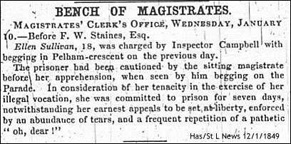[This document comes from Helena Wojtczak's English Social History: Women of Nineteenth-Century Hastings and St.Leonards. An Illustrated Historical Miscellany, which the author has graciously shared with readers of the Victorian Web. Click on the title to obtain the original site, which has additional information.]

Hastings High Street in the nineteenth century
As soon as the Hastings police force was formed in 1836, it had to deal with street drinkers, whose main crime (then as today) was to make the place look untidy. In mid-nineteenth century Hastings, and more especially St Leonards, this was a very grave matter, for they may have repelled the well-bred visitors upon whose patronage the economy of the two towns almost entirely depended. Therefore, a person could be arrested and jailed simply for being drunk in a public place, or for sleeping in the open air. A first offender might be ordered to leave town, but punishments for repeat offences were exceptionally harsh by today's standards: even knocking on a rich person's door and politely requesting a few pennies or some bread attracted harsh punishment. For example, Ellen Robinson, aged 67, was jailed for 14 days after "a lady" complained of her begging at Eversfield Place.
When fines were imposed, the magistrates knew the miscreants could not pay, and that enabled them to remove the offender from the public eye by jailing them for 14 or 21 days in the lock-up in Courthouse street. (In 1851 "serial beggar" Sarah Harvey was sentenced to a month.) There was much petty shoplifting and, until the 1840s, thieves could be transported. In 1825 Mrs Anne White stole three packs of playing cards from a shop at 5 High street and was sent to Australia for seven years.

A contemporary newspaper Court report
People who fell on hard times could apply to one of the many relief organisations. The primary and secondary sources reveal little of prostitution in Hastings. The newspapers shrank from offending their readers and recent historians, too, omit the subject. However, it is likely to have been rife in a town with so many male visitors and impoverished women.
The antics of the underclass are revealed in the contemporary Magistrate's Court Reports in the local newspapers. These were served up, in humorous style, as entertainment for the more fortunate, but they give us an insight into the lifestyles of the very poorest people in the towns.
Last modified 2000